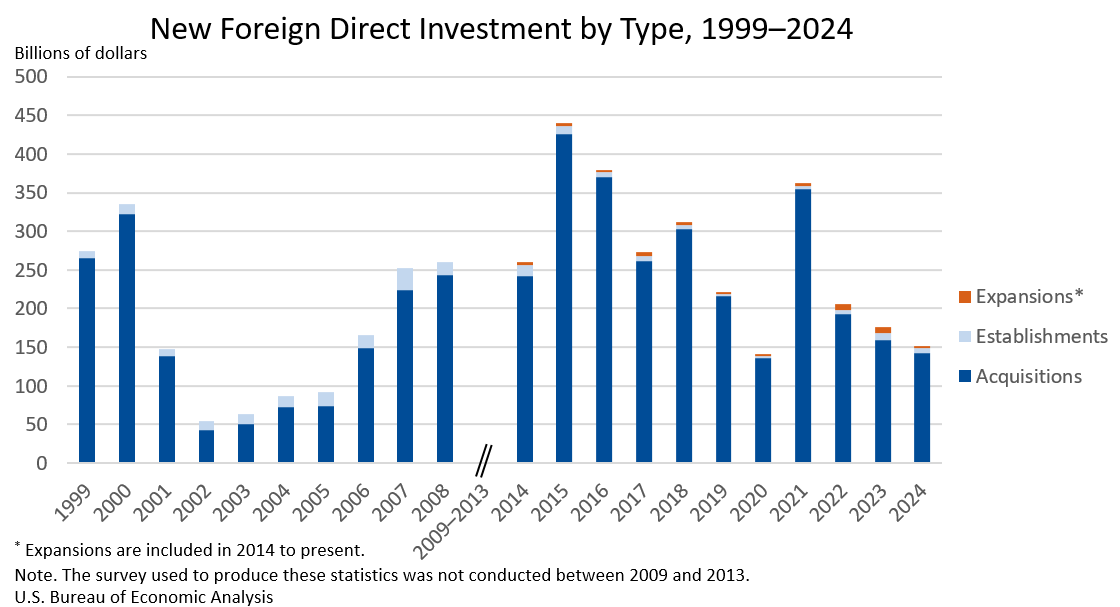Bureau of Economic Analysis
New Foreign Direct Investment in the United States, 2024
Expenditures by foreign direct investors to acquire, establish, or expand U.S. businesses totaled $151.0 billion in 2024, according to preliminary statistics released today by the U.S. Bureau of Economic Analysis. Expenditures decreased $24.9 billion, or 14.2 percent, from $176.0 billion (revised) in 2023 and were below the annual average of $277.2 billion for 2014–2023. As in previous years, acquisitions of existing U.S. businesses accounted for most of the expenditures.
Principal Federal Economic Indicators
Noteworthy
- 2025 News Release Schedule
- Innovation at BEA
- 2025 Annual Updates
- New! Services Trade Data for More Countries
- Data Tool: Trade in Value Added
- Distribution of State Personal Income
- Updated: RIMS II Regional Multipliers
- Arts and Culture
- Space Economy
- FDI Now in State BEARFACTS
- Quick Guide: Price Indexes
The Latest
Personal Income and Outlays, October 2013
Personal income decreased $10.8 billion, or 0.1 percent, and disposable personal income (DPI) decreased $23.6 billion, or 0.2 percent, in October, according to the Bureau of Economic Analysis. Personal consumption expenditures (PCE) increased $32.7 billion, or 0.3 percent. In September, personal income increased $64.3 billion, or 0.5 percent, DPI increased $62.1 billion, or 0.5 percent, and PCE increased $23.8 billion, or 0.2 percent, based…
GDP Growth Picks up in Third Quarter
Real gross domestic product (GDP) increased 3.6 percent in the third quarter of 2013, according to the “second” estimate released by the Bureau of Economic Analysis. The growth rate was 0.8 percentage point more than the “advance” estimate released the previous month. In the second quarter, the growth rate was 2.5 percent.
Gross Domestic Product, 3rd quarter 2013 (second estimate); Corporate Profits, 3rd quarter 2013 (preliminary estimate)
Real gross domestic product -- the output of goods and services produced by labor and property located in the United States -- increased at an annual rate of 3.6 percent in the third quarter of 2013 (that is, from the second quarter to the third quarter), according to the "second" estimate released by the Bureau of Economic Analysis. In the second quarter, real GDP increased 2.5 percent. The GDP estimate released today is based…
Gross Domestic Product for Guam, 2011-2012
This release is available as a PDF download.
October 2013 Trade Gap is $40.6 Billion
The U.S. monthly international trade deficit decreased in October 2013 according to the U.S. Bureau of Economic Analysis and the U.S. Census Bureau. The deficit decreased from $43.0 billion in September (revised) to $40.6 billion in October as exports increased more than imports. The previously published September deficit was $41.8 billion. The goods deficit decreased $2.2 billion from September to $60.2 billion in October; the services…
Guam's Economy Grows 0.5 Percent in 2012
Newly published estimates for Guam show that real gross domestic product (GDP)—GDP adjusted to remove price changes—increased 0.5 percent in 2012, after decreasing 0.6 percent in 2011.
For comparison, real GDP for the United States (excluding the territories) increased 2.8 percent in 2012 and 1.8 percent in 2011.
In 2012, the increase in real GDP reflected an improvement in the trade balance. Exports of services—primarily…
Northern Mariana Islands' Economy Grows in 2012, Shrinks in 2011
Newly published estimates for the Commonwealth of the Northern Mariana Islands show that real Gross Domestic Product, GDP adjusted to remove price changes, increased 5.2 percent in 2012 after decreasing 6.8 percent in 2011.
For comparison, real GDP for the United States (excluding the territories) increased 2.8 percent in 2012 and 1.8 percent in 2011.
Gross Domestic Product for the Commonwealth of the Northern Mariana Islands (CNMI), 2011-2012
This release is available as a PDF download.
Some Local Economic Statistics Eliminated Due to 2013 Budget Sequester
You probably noticed that today’s release of the Bureau of Economic Analysis’ (BEA) local area personal income statistics is missing some detail that’s normally included. Why?




